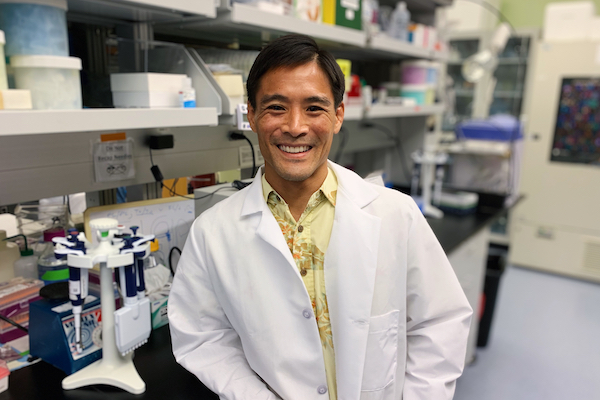
This weekend, the John A. Burns School of Medicine is conferring PhDs on a handful of hardworking scientists including Brooks Mitchell of Hilo, and Brent Fujimoto who grew up on Sand Island at the University of Hawaiʻi-Mānoa Commencement Exercises at the Stan Sheriff Arena. A few weeks ago we profiled soon-to-be “Dr.” Mitchell. Today, we focus on Fujimoto.
Brent Fujimoto, a doctoral student at the John A. Burns School of Medicine (JABSOM) who will graduate next week, has made important headway in understanding insulin-induced glucose uptake.
“The inhibited uptake of sugar is a concern in people with diabetes,” he explained. “In our lab, we discovered a novel role for a set of proteins called the Exocyst complex. The Exocyst is important for making sure that other proteins end up in the right place at the right time in a cell. We were the first to show that the Exocyst is essential for directing sugar transporters to the surface of muscle cells.”
Fujimoto studied the chemistry, biology and physics behind food manufacturing processes during his undergraduate years at Oregon State University (OSU). Upon receiving a B.S. in Food Science and Technology from OSU in 2003, he pursued graduate degrees in similar areas. “Earning an M.S. in Animal Science from California Polytechnic State University in 2008 taught me about how our bodies process the food that we eat,” he said. “This November, I defended my Ph.D. thesis in Developmental and Reproductive Biology, where I studied Type 2 diabetes.”
Early setback
As a new Ph.D. student at the University of Hawaiʻi’s Institute for Biogenesis Research, Fujimoto initially examined stem cells and regeneration in a native Hawaiian marine worm called Ptychodera flava. Unfortunately his advisor, Dr. Tom Humphreys, passed away about a year later. Fujimoto attempted to carry on his research while working as a lecturer in anatomy and physiology at Kapiʻolani Community College. “Eventually,” he said, “it became apparent that I would no longer be able to continue the project on my own and my prospects of earning a Ph.D. became very bleak.”
Fujimoto was able to overcome this setback when, with the help of Drs. Allan Wang and Katalin Csiszar, he was introduced to Dr. Ben Fogelgren. “Ben, as many of us know, is an extremely kind, talented, hard-working up-and-coming researcher here at JABSOM,” Fujimoto remarked. “It has been an extreme honor to work with him and his colleague Dr. Noemi Polgar, who is also very talented, kind and hard-working, on the project that would eventually become the basis for my Ph.D. thesis.”
Studies that Fujimoto has been involved in have produced exciting results. “In Dr. Fogelgren’s lab we discovered that the absence of a single gene, EXOC5, during embryo development resulted in obstructed ureters and subsequent hydronephrosis,” he said. “With Dr. Polgar, we discovered that the absence of EXOC5 in skeletal muscle cells inhibited the cells’ ability to uptake glucose in response to insulin.” This latest finding comprised Fujimoto’s thesis work and led to a publication in the American Journal of Physiology in October 2019. Earlier, working with Dr. Humphreys, he was in the process of discovering that genes that are artificially expressed in mammalian induced pluripotent stem cells are naturally expressed in Ptychodera.
Collaboration, workforce preparation are positives at JABSOM
Fujimoto greatly appreciates the openness to collaboration at JABSOM. “In Dr. Fogelgren and Dr. Polgar’s laboratories, there is a strong sense of teamwork and unity. Both of their labs do an outstanding job of combining the efforts of each member in order to accomplish a common goal, which creates an atmosphere that feels almost like a family away from home.” Monthly meetings at the Cardiovascular Research Center, at which researchers from participating labs present their latest findings, provide valuable opportunities to exchange comments and ideas.
Fujimoto is optimistic about his future. “Despite the long odds and frightening job statistics,” he said, “I would like to become an academic researcher someday. It will definitely require some hard work, an open mind, and an unwavering belief that I can do it.”
Growing up on the Anuenue Fisheries Research Center on Sand Island in Honolulu, Fujimoto became interested in science because of his father, who works in aquaculture research and fisheries management. “I didn’t have any neighbors to play with,” he recalled, “but I was able to spend many hours observing and harassing fish, and tending a garden where we would try to grow plants that could tolerate the salty soil and air.” Fujimoto is a Punahou high school graduate. “We didn’t have cable television and I had a lot of time to think about the ‘why’ behind the phenomena of life. I remember having a subscription to Zoobooks magazine, which was pretty awesome.”
A Hawaii kid who loves snow!
Fujimoto enjoys cold weather and snowboarding. “Believe it or not, I’ve always been fascinated and enamored by life in cold and snowy areas. My mom grew up in the foothills of Mt. Hood in Oregon and the times we visited my relatives during Christmas break were probably my happiest moments as a child.”
Today he likes to visit Hokkaido, Japan, an island known for its abundance of powdery snow in wintertime. Fujimoto also participates every year in the Honolulu Marathon, the Hapalua Half-Marathon, and the Great Aloha Run.
He received his black belt in Brazilian jiu-jitsu in 2018 and has surfed regularly since he was a teenager. His favorite places in Hawaiʻi he said, are “the semi-secret surf spots that are cumbersome to access, or few people know about. My nightmare is that those places get crowded someday, so I always tell people that I see tons of sharks out there.”